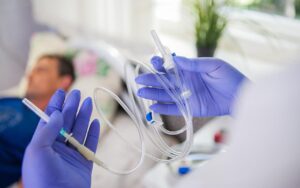Usually begins with the treatment of alcohol withdrawal or the prevention of alcohol withdrawal.
As a rule, a patient comes to the clinic with alcohol withdrawal or alcohol intoxication. We have to prevent the development of a severe hangover. This is actually very important to do. Because if we can prevent the development of a severe hangover syndrome, we can avoid complications such as white fever and alcoholic epilepsy.
We have to be materialistic. If a person is admitted to our clinic who has already had three episodes of white fever, the fourth is likely to develop within our walls. At the same time, we will not be able to avoid it. But if we give the patient the medications he needs, if we treat him according to rational approaches, then we will at least mitigate the course of delirium and our patient will not die. In the best clinics of the world, the mortality rate for white fever is 5 to 8%.
After we have finished treatment of this patient, we have finished treatment of his physical dependence, detoxification has gone, we have removed his hangover state, – after that we do our best to make sure that our patient does not start drinking again. That is to say, we do counter-cycling therapy.
Unfortunately, very many patients cannot stop drinking altogether. Three-quarters of alcoholics start drinking again soon after leaving rehab. What, do we have to stop treatment? Of course you can say, “You know, you have no motivation for treatment, so we’re not going to treat you. Go and look for motivation, come back with motivation, and we will continue treating you. But if a patient finds motivation not to drink, probably he won’t need doctors anymore. On the other hand, imagine: a cardiologist has a patient with hypertension. The cardiologist treats him. And suddenly the patient’s blood pressure goes up again. The cardiologist won’t say: “Look, you’re not motivated to treat. Why am I treating you? I’m just wasting my energy on you”. In other words, we have to mitigate the disease in those people who cannot or do not want to stop drinking altogether.
Actually, in addiction medicine, “can’t” and “doesn’t want to” are probably synonyms. And on the other hand, we have to mitigate the disease, because it has its resonances – such patients will live longer. With a better quality of life. We make their disease not fatal for them. And if we treat such patients and they don’t quit drinking altogether, then our therapy is no longer counter-cyclical, it’s supportive. Like, say, supportive therapy for hypertension (not a single therapist, not a single doctor has yet been able to cure hypertension. The doctor’s job is to select hypotensive drugs: ACE inhibitors, beta-blockers, diuretics, etc., so that the patient’s blood pressure is in a safe range. To minimize the risk of stroke. So that the patient will live to be 95 years old and die in his sleep with a smile on his lips).
A couple of phrases about pharmacotherapy for alcoholism and its harmful effects
With what does treatment in narcology usually begin? With IVs. “You need to lie down to be pumped,” we usually tell our patients. You need to get your blood cleaned. But we remember that the proverbial “blood cleanse” has no effect on addiction.
What is alcohol withdrawal? It is the cry of the brain receptors for a new batch of the substance. If ethyl alcohol, which is a GABA agonist, comes in from outside, the lack of ethyl alcohol makes the GABA receptors, the benzodiazepine receptors and the chlorine channel overexcited, so when such a receptor complex is overexcited, it wants a little more Courvoisier or Poutine. Or at least benzodiazepines, since the receptors are called benzodiazepine receptors.
So do we need IVs for alcoholism? Of course they are. And not only because there is a demand from the client base (if for rational reasons the patient is not given IV drugs, it is perceived by the patient and his relatives as a shoddy job, a shortcoming of the clinic). But our patients, as a rule, are dehydrated and it is necessary to raise the volume of recirculating fluid in the body. And practically all our patients have potassium and magnesium ions deficit, the blood pH is shifted to the left, i.e. the acid-base balance is disturbed, myocardium and the cardiac muscle are overloaded. And here drip, diffusion therapy, is very much needed.
Going back to benzodiazepines: diazepam and its analogues are superior to anticonvulsants in their ability to prevent alcoholic seizures and superior to neuroleptics in their ability to prevent alcoholic psychosis. Diazepam is very similar to alcohol, it pushes the same buttons – so it is preferable to haloperidol for preventing alcoholic psychosis. Any neuroleptic knocks down dopamine levels in the prefrontal cortex. And people don’t have enough dopamine as it is. So our choice is not an antipsychotic that exacerbates the need for alcohol, but diazepam.
(There have been attempts to treat alcoholism with antipsychotics in many countries. But then there were meta-analyses – comparing systematic reviews of the most correct scientific studies. Conclusions from these analyses: antipsychotics either do not affect the structure of addiction, or they worsen it – at least because in patients with alcoholism, under the influence of antipsychotics, understanding deteriorates, psychotherapy is devalued).




